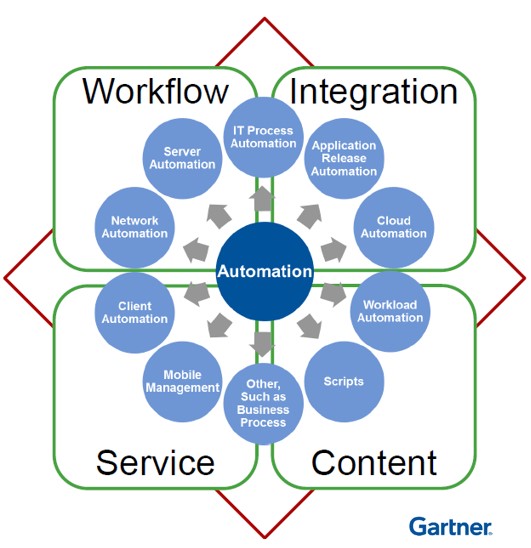A few weeks ago, I had the opportunity to attend the Gartner IT Operations Strategies and Solutions Summit in Orlando, Florida. Speaking with attendees, it became evident that organizations not currently using IT Automation solutions were being prompted to implement them.
Some major reasons cited by attendees being driven to automate included efficiency, cost reduction, risk mitigation, and predictability. These were echoed during several of the conference sessions as well, with poll results revealing that more than 75% of organizations have automation goals and initiatives, but that their current strategy is happening only in specific functional groups, with central management of IT processes merely in its infancy. Despite the challenges of implementing enterprise automation, Gartner research is clear: Organizations should automate wherever possible and have clear objectives when evaluating and implementing a solution.
Here are 5 Things to Consider When Evaluating an Enterprise Automation Solution:
1. Ease of Implementation
According to Gartner research, fundamental challenges to the implementation of a true organizational IT automation strategy include a shortage of people and skills, cultural resistance, a lack of process and workflow creation expertise, and the perceived difficulty of consolidation of automation tools already in place. The enterprise automation solution should overcome as many of these objections as possible with simple installation and rapid organizational implementation.
2. Powerful Capabilities with Ease of Use

The automation solution must accelerate time to value. It should allow the IT organization to develop and implement end-to-end workflows faster and more reliably, avoiding, whenever possible, the need for error prone, expensive custom script creation, while also protecting the IT organization’s existing script investment. The solution should move the organization toward dynamic automation, consistently addressing changing business requirements.
3. Depth of Automation Capabilities
A cross-functional solution can coordinate, manage, and execute processes and tasks for both the business and the IT organization across the enterprise. The enterprise automation solution should be able to automate, for example, managed file transfers or provisioning of cloud resources on the IT side, as well as onboarding on the business side. Your team should have the ability to build workflows with more complex logic, using templates and workflows with intelligent helpers.
4. Breadth of Functional Integrations
Gartner research tells us that most organizations have multiple automation tools. Generally, each tool is managed by a separate individual or team, resulting in an increased cost of operations and decreased IT agility. The more organizations can consolidate and aggregate the automation of key business applications and technologies, the more they will benefit as a result. Therefore, seamless cross-functional automation — the coordination, management, and execution of processes, activities, and workflows to deliver IT and business services — is critical. The solution should offer direct integration for third party applications, databases, and platforms, reducing the organization’s reliance on multiple scripting or platform-specific point tools to automate processes.
5. Don’t Forget About Support!
One of the overlooked considerations when evaluating and selecting an enterprise automation solution is the quality of the vendor’s Technical Support Team. Don’t get trapped dealing with expensive annual support cost increases, outsourced support, or lack of timely responses to your issues. Cases should be managed directly by product experts. The Support organization should have seamless interaction with Engineering for rapid communication and reduced resolution times.
